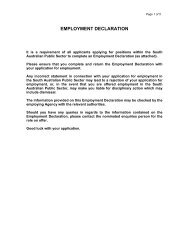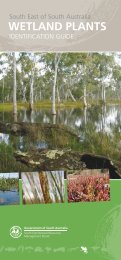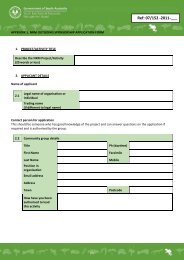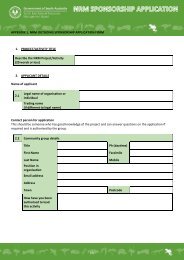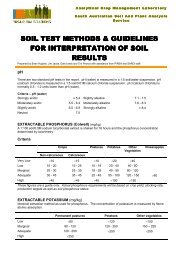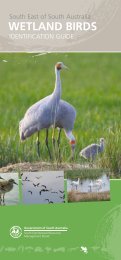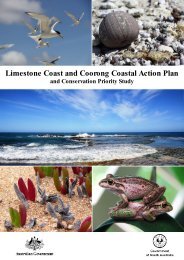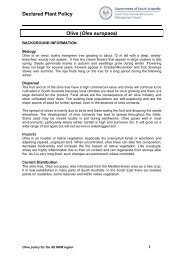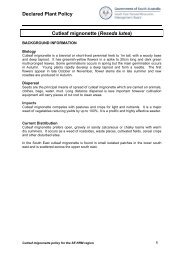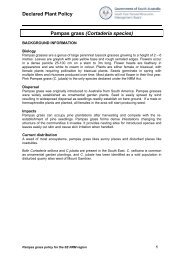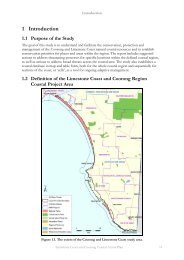Cell Descriptions - South East Natural Resources Management Board
Cell Descriptions - South East Natural Resources Management Board
Cell Descriptions - South East Natural Resources Management Board
You also want an ePaper? Increase the reach of your titles
YUMPU automatically turns print PDFs into web optimized ePapers that Google loves.
SE10 – Little Dip CP<br />
(Criterion 1). Several of these wetlands are also considered important as habitat for animal taxa at<br />
a vulnerable stage in their life cycles, or provide refuge when adverse conditions such as drought<br />
prevail (Criterion 3). As a wetland complex, these wetlands are a particularly unique geological<br />
and ecological feature of the <strong>South</strong> Australian coastline. Very few coastal dune wetlands (i.e.<br />
those occurring in dune swales of the coastal fringe) occur outside of the stretch of coast<br />
between Beachport and Robe. Within their own group, many of these wetlands have unique<br />
properties with respect to water quality (e.g. salinity), hydrologic al regime and vegetation type,<br />
providing a broad diversity of habitats for wetland dependent fauna (Billows 2009).<br />
Several of these wetlands have been assessed as Pristine or Intact from LSEWI field surveys and/<br />
or rated highly for Biological Condition Value and/ or Ecological Significance (see Appendix 3<br />
of Billows 2009). Many are well buffered from adjacent land use by coastal dune scrub and<br />
protected from livestock damage via fencing. Others are situated within the Little Dip<br />
Conservation Park. Biological records are poor for many of these wetlands due to a distinct lack<br />
of survey effort in this area, particularly on privately owned land. However, observations indicate<br />
that these wetlands are important habitat for a broad range of flora and fauna, including local and<br />
migratory waterbirds and waders (Billows 2009).<br />
Conservation Analysis (GIS)<br />
The total of conservation means is 123.02, average for the region. The detailed summary<br />
conservation layer shows an extremely complex pattern, although the highest values are found in<br />
well established dune vegetation and in narrow lake edge swamps. The intricate pattern of values<br />
also reflects the pattern of vegetation loss, through clearance and through dune blowout<br />
development.<br />
All areas outside the urban land and the de-vegetated dunes show high values for vegetation<br />
associations and threatened plant and animal species. The lakes show moderate to high values,<br />
especially in the lakeside vegetation, for all birds and threatened bird species; lake edges for<br />
reptiles and threatened mammals. Butterfly habitat is widespread through the dunes and lake<br />
edges. Focal species show varied habitat through the cell: Orange bellied Parrot in the dunes;<br />
Fairy Tern and <strong>South</strong>ern Bell Frog in the lakes; Swamp Skink in the lake edges; and Yellow Sedge<br />
Skipper in the Gahnia sedge of the lakes edges. [Wetland assessment gives top rating to Lake<br />
Robe and a high rating to Lake Eliza].<br />
Threat Analysis (GIS)<br />
The total of threat summary means is an average one, 58.69.<br />
The highest contributors to the means total are visual amenity, mining activities (tenements cover<br />
the entire cell), vegetation block degradation and distribution of significant weeds, dune<br />
instability and rabbit numbers. Valuable lakeside habitats are also threatened by land use and<br />
ownership. Existing development contributes to threat totals on the fringes of Robe and Nora<br />
Creina.<br />
Adaptation to Climate Change: Threats for <strong>Cell</strong> SE10<br />
(see also discussion of scenario in Section 4.11<br />
NOTE: the advice below is indicative of likely change and the direction of change, with<br />
implications for ecosystems. Dates, amounts and probabilities cannot be accurately calculated at<br />
this time. Thus advice on flood levels, for example, should not be used in engineering or<br />
development planning.<br />
Limestone Coast and Coorong Coastal Action Plan 372



